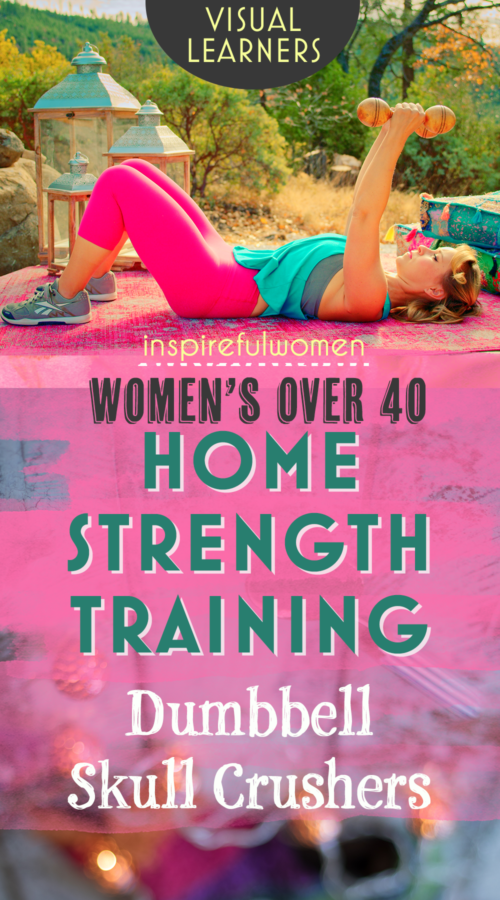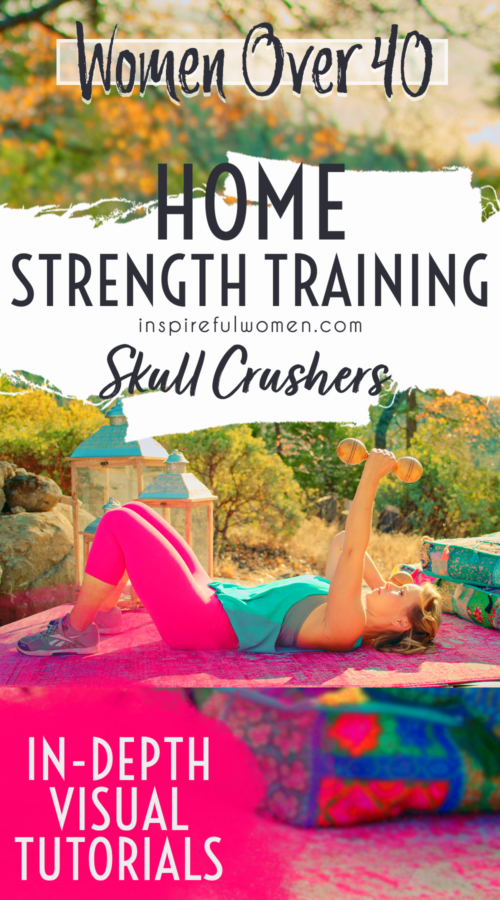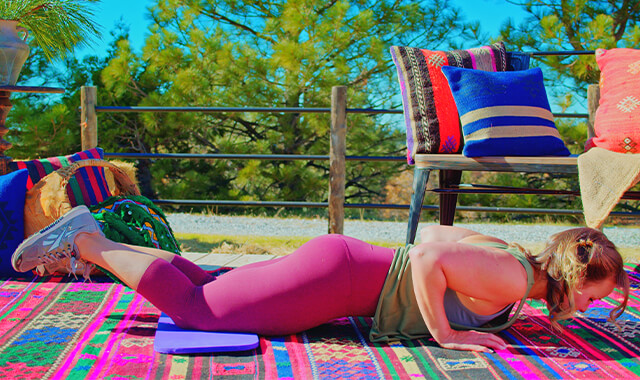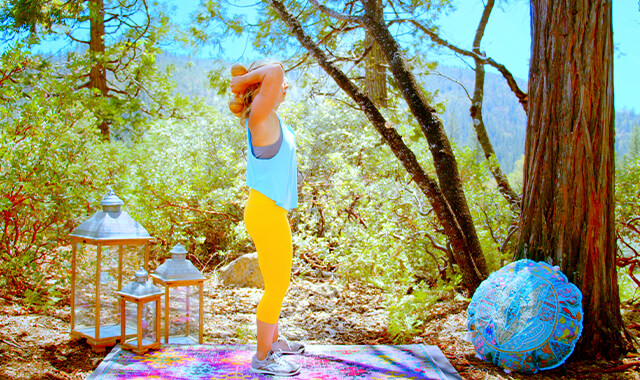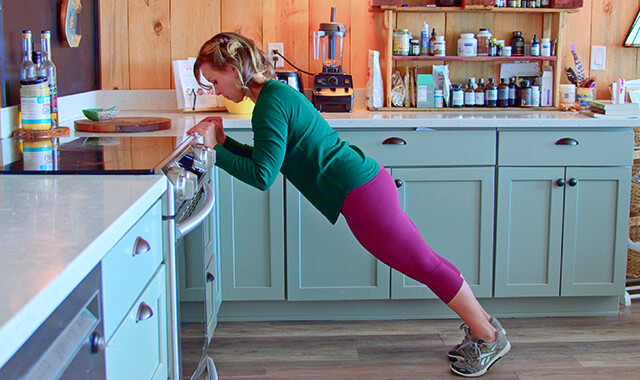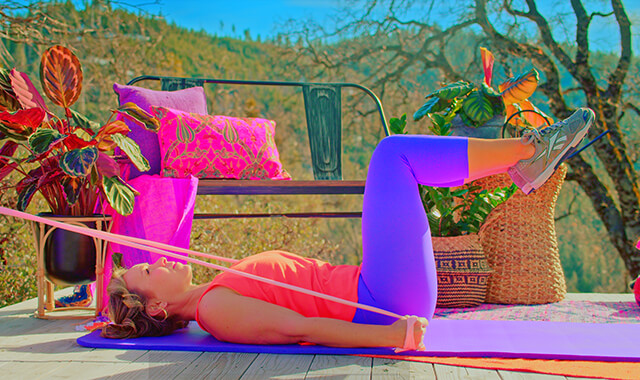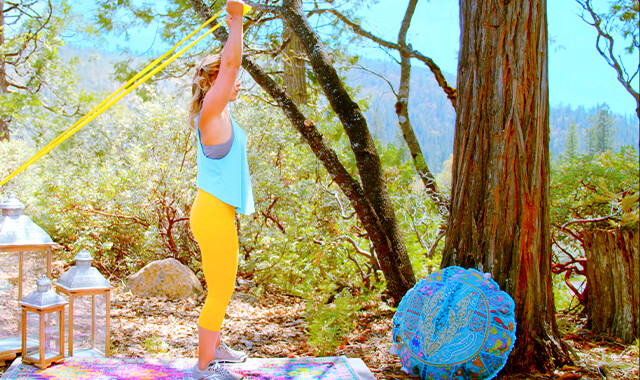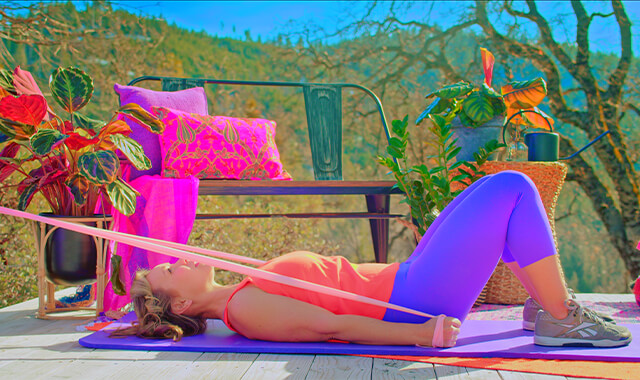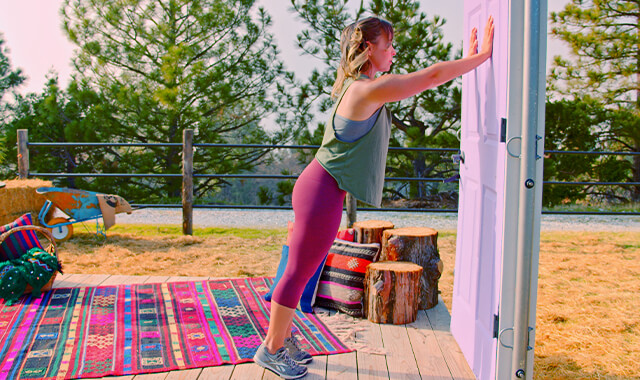Dumbbell Tricep Skull Crushers
How to Do Skull Crushers - Lying Overhead Dumbbell Triceps Extension | In-Depth Guide [VISUAL LEARNERS] Beginner
Proper Form, Common Mistakes, & Variations + Easier & Harder | Home Resistance Training
WHAT DO YOU WANT TO SEE?
QUICK DEMO
QUICK DEMO
MUSCLES THIS WORKS
MUSCLES
MAIN MUSCLES WORKED IN DUMBBELL Triceps SKULL CRUSHERS
Triceps
WHAT WE'RE DOING TODAY
WHAT & WHY
BENEFITS OF TRAINING YOUR TRICEPS MUSCLES
WHAT
WHAT WE'RE DOING TODAY
Dumbbell Triceps Skull Crushers work the muscles on the back of the arm, called the triceps. The triceps cross the elbow joint and their job is to straighten the elbow. The exercise is performed by lying on the floor and holding a dumbbell in each hand, with the arms extended overhead. This exercise helps to build strength and mass in the triceps, which can improve the overall appearance of the arms and increase arm strength.
ALL WE'RE DOING:
Lay down. Oh yeah. Bend your elbows. Straighten them. You're done! :)-
They are called triceps because this muscle is made up of three different parts - the long head, the medial head, and the lateral (side) head. The position of the arms and the movement of skull crushers will work all three parts of the triceps.
This exercise is done lying down, face up, so it is good for focusing on the triceps muscle without having to work to hold the rest of your body still. The position also works the muscles of the shoulder and chest and back to hold the arm and weights close to the body. The movement of the exercise is simply bending and straightening your elbows.
WHY BOTHER DOING IT?
WHY
WHY DO WE EVEN CARE?
IMPORTANT MUSCLE OF OUR ARMS
The triceps muscle is the largest arm muscle and it makes up most of the bulk of the upper arm. When a muscle is a large portion of one of our limbs, that gives us the idea that it's important to a lot of what we do in life.
BALANCE OUT THE BICEPS MUSCLE
The triceps lies along the backside of the upper arm and balance out the biceps brachii muscle which lies along the front of the arm.
The triceps work with the biceps to control the movements of your arms. It is important to include exercises that work the triceps to balance out the strength of the biceps.
WE STRAIGHTEN OUR ARMS A LOT IN DAILY LIFE
We use our triceps in most daily activities, not only to straighten our elbows but to hold the elbow still when we use our hands. Since we do this so much everyday, it makes sense to strengthen the muscles that achieve this!
EVERYDAY LIFE
EVERYDAY LIFE &
MUSCLE FUNCTION
HOW WE USE OUR TRICEPS IN EVERYDAY LIFE
1. STRAIGHTEN THE ELBOW
This is the triceps primary function - all 3 heads do this.
- Pushing an object overhead
- Pushing a door open or shut
- Chopping - swinging down
- Hammering - swinging down
- Sawing - pushing out
- Pushing up from the floor
You can see in all these cases, your arm is going from being bent, to straightening - the triceps make this happen.
2. PULLS THE ARM DOWN WHEN IT IS OVERHEAD (1 TRICEPS MUSCLE)
The long head of the triceps muscle, the one that also crosses our shoulder joint, helps us pull our arm down fro overhead - this is calle shoulder extension.
- Pulling a cord to open a curtain
- Pulling a window down to shut it
3. HOLDS THE ELBOW JOINT STILL
All 3 heads stabilize the elbow joint while we are holding our arms/elbows in a certain position to do an activity for a length of time, and the long head also stabilizes the shoulder joint in the same manner. Examples - during:
- Writing
- Pushing a stroller or grocery cart
- Using a screwdriver or knife
- Knitting
- Replacing a ceiling lightbulb
You can see in all these cases, the arm being held somewhere in space for a length of time- the triceps muscle is helping to keep the elbow joint stable while you do that.
STARTING POINTERS
Starting Pointers
This is that standard Skull Crusher exercise.
The exercise is done lying down on your back so you may be able to use heavier weights. Holding one heavy dumbbell in each hand will work the muscles on the back of the arm, as well as the muscles of the chest, and all the muscles that help to hold the shoulder, elbow and wrist stable while the elbow bends and straightens.
HOW TO FEEL WHAT MUSCLE IS WORKING
How to Feel What Muscle is Working
I think it's good to know where on our body should be working/burning when we do an exercise - this will make sure we are actually working that muscle, or to make adjustments if we are not feeling it there. It's very easy to do an exercise with improper form and have other muscles doing the work. Once we have that mind-muscle connection, we can get better results with less reps and sets.
To feel your triceps muscle activated: Lift your arm in front of you and set the hand and forearm on a table or counter. Put your other hand on the back of your upper arm. Press down with the hand resting on the surface.
1) Press down as if you were trying to straighten just your elbow;
2) Press down as if you were trying to pull your upper arm down to your side.
In both cases, you should feel your triceps working.
HOW TO DO THE EXERCISE
LOOKS
HOW DUMBBELL TRICEPS SKULL CRUSHERS SHAPE OUR BODY
Balances out biceps in the upper arm, gives our upper arm that horseshoe definition which is caused by workings all three heads of the triceps. All three heads together when trained make up the "horseshoe" appearance.
PROPER FORM
PROPER FORM: DUMBBELL TRICEPS SKULL CRUSHERS
EQUIPMENT, SETS & REPS
EQUIPMENT
SUGGESTED STARTING WEIGHT FOR WOMEN:
8-10 lb dumbbells
SETS & REPS:
2 sets of 8-10, must fatigue the muscles.
PACE:
Moderate up - with control and back stability, and lower down for the eccentric component.
BODY POSITION
BODY POSITION FOR THE DUMBBELL SKULL CRUSHER
Position the dumbbells on the floor one on each side of you, beside each hip.
BODY STANCE: Lying on the floor face up. Knees bent. Shoulder blades together and down your back, abdominals engaged - neutral spine, sternum lifted, throughout the exercise. Make sure your shoulders are pushed back to the floor so the chest is open.
FEET: Feet hip-width apart, toes forward, feet flat on the floor.
HAND/GRIP: Palms facing each other (neutral grip). The position of your forearm will not affect the triceps muscle activity - the grip should be comfortable.
ARMS: Arms by your side, grip weight, and lift up to your chest. Your arms are held up straight in front of your shoulder at 90 degrees of flexion (straight up) - this means your arm will be perpendicular to the ground. Bend your elbows so that the weights are close to your ears. The goal is to have your elbows and hands in close but making sure that you have enough room to safely move the weights up and down.
NECK: Neutral and relaxed throughout the exercise.
HOW TO DO
HOW TO DO THE DUMBBELL SKULL CRUSHER
CUE: Isolate the movement to the elbows. Keep the upper arms and shoulders still.
- Keeping your elbows still, and your upper arm perpendicular to the floor, straighten your elbow to lift the dumbbell. This can be a faster 1 second up.
- Make sure that your elbows are fully straight (extended ) but not hyperextended (so the elbow bends backward) or locked.
- To return to the starting position, slowly bend your elbows. This is the eccentric/lowering portion of the exercise, so do this with control, feeling your tricep muscle lowering the weight, not just gravity.
- Repeat until fatigue or the desired # or reps are completed.
HOW TO SAFELY GET OUT OF THE EXERCISE
Lower upper arm to floor, straighten elbow and set one weight on each side of you.
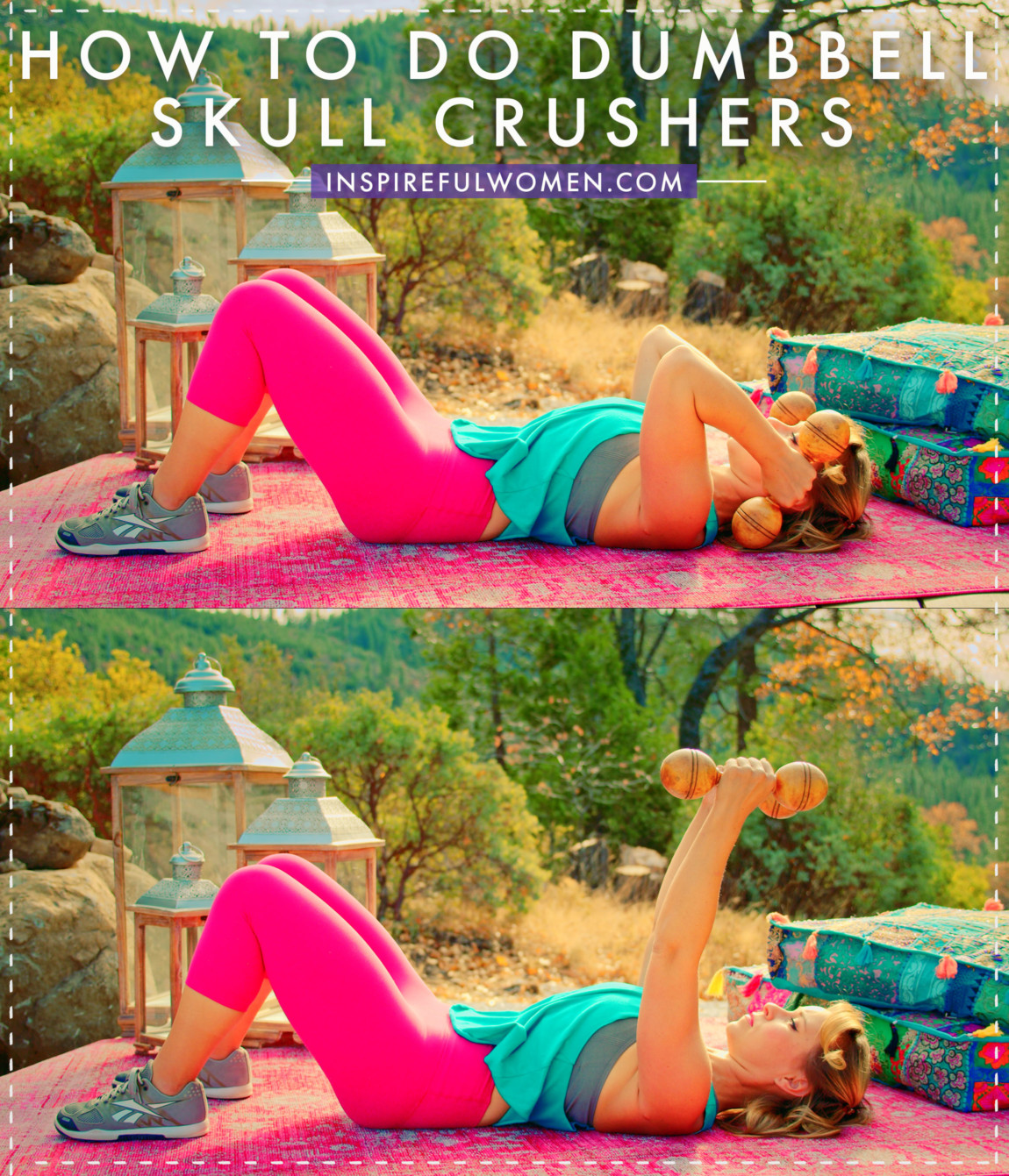
COMMON MISTAKES
COMMON MISTAKES
WHAT TO AVOID WITH THE DUMBBELL SKULL CRUSHER
KEY TIP:
Guess what? Good news! Many avoids are the same for most movements. Once you learn the basics, there's really only a few extra avoids for each individual movement.
1. Avoid letting the elbows flare out
Avoid letting your elbows flare out/move away from the sides of your body outward.
- This moves the shoulder joint into internal rotation and decreasing the space between the top of the shoulder blade (the acromion process of the scapula) and the upper arm bone (humerus)
- This can irritate the tissues
- Reduces the effectiveness of the exercise
- Makes it more difficult to get full elbow extension at the top of the movement
- Keep the elbows in and pointing up to the ceiling
Instead, keep the elbows close to your torso, more in line with your shoulder joint as able.
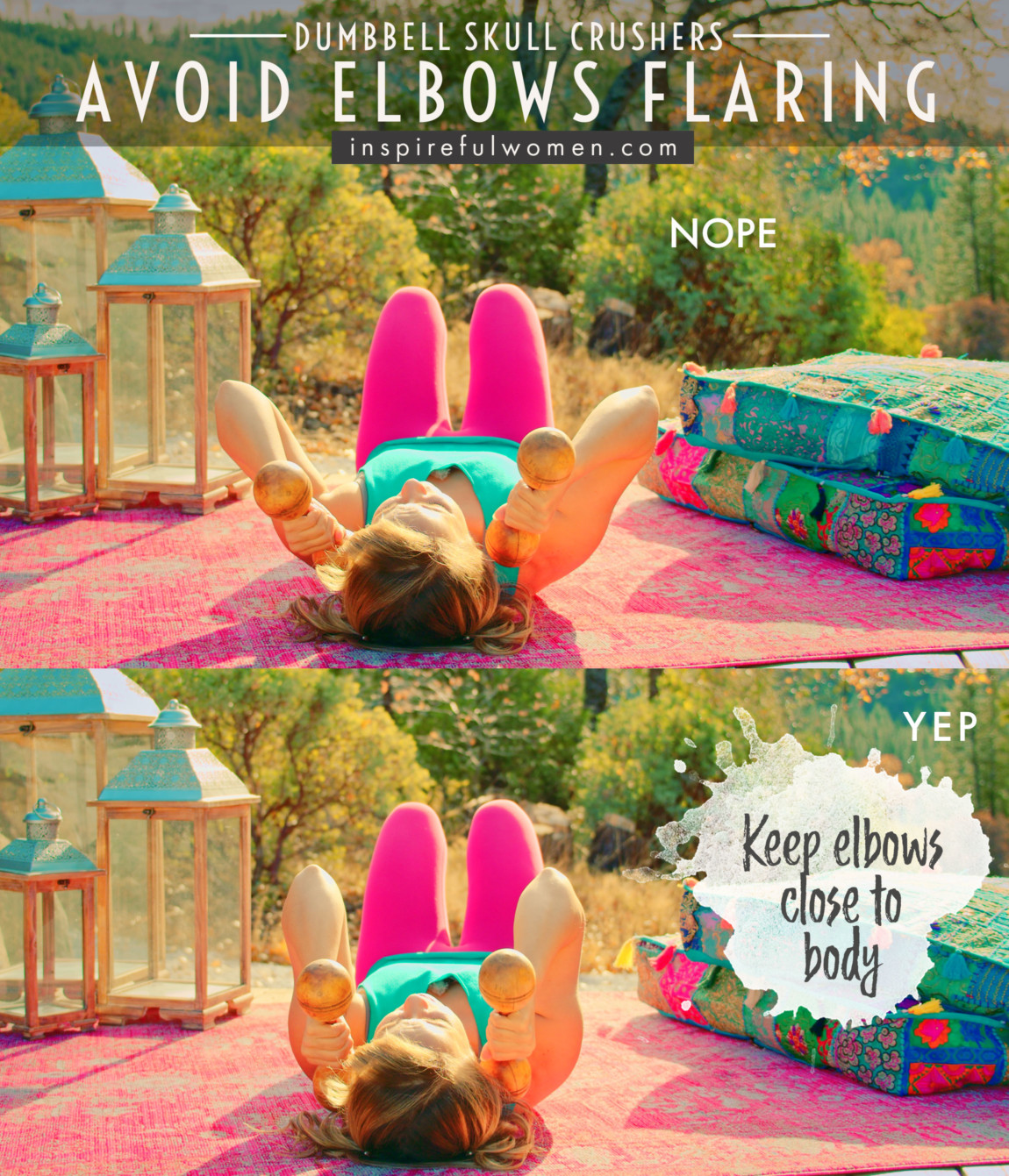
2. Avoid letting the backs of the shoulders lift off of the floor
Avoid letting the backs of the shoulders lift of the floor.
- This will promote poor posture
- Tight chest muscles
- Will not work the scapular retractors (muscles that pull the shoulder blades back)
- Press the backs of the shoulders to the floor
- Pull the shoulder blades back
- Lift the sternum
Instead, think about pressing your shoulders back into the floor, keeping a wide, broad chest during the movement.
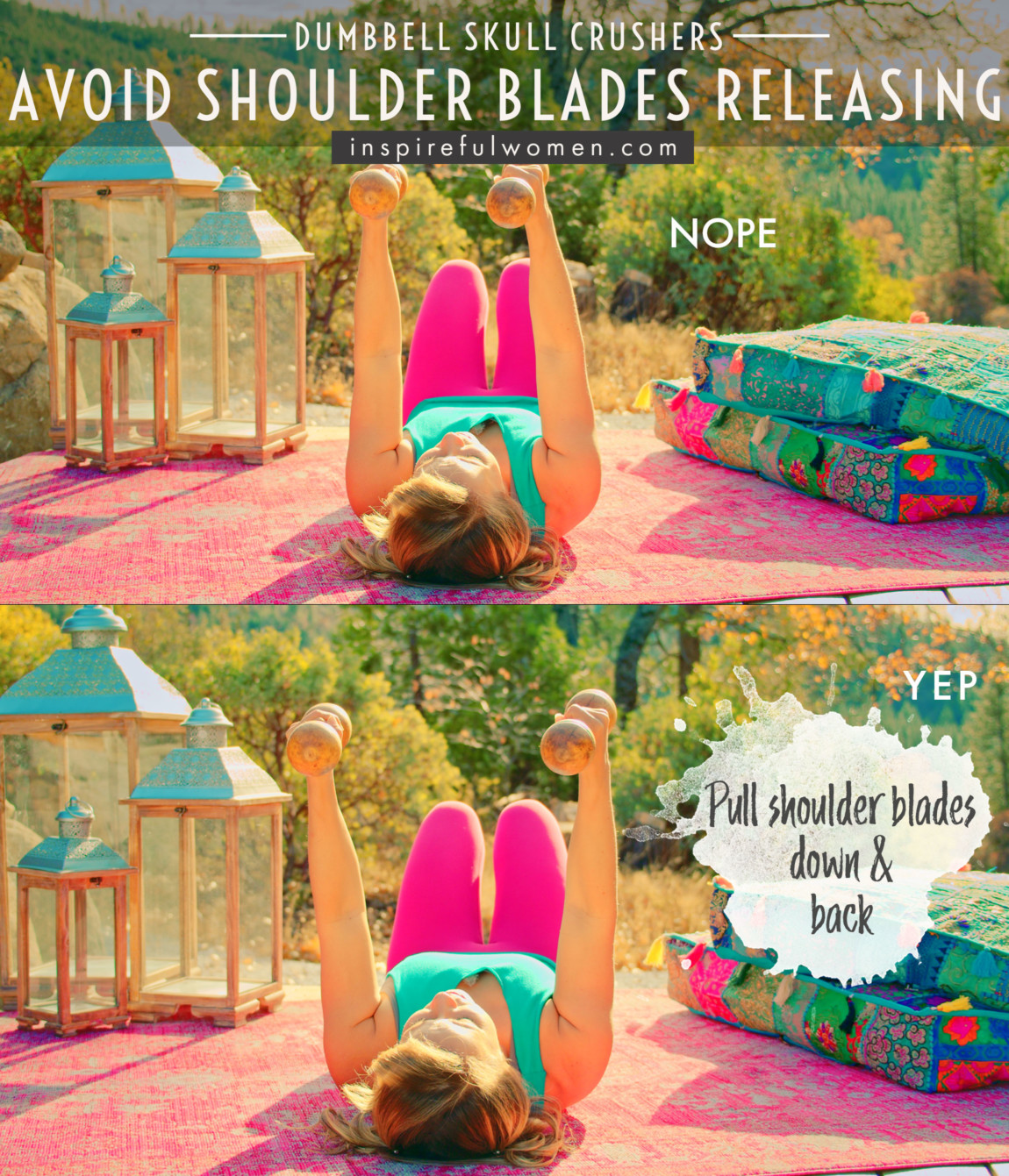
3. Avoid letting your upper arm drift down
Avoid letting the portion of your arm from your shoulder to the elbow (the upper arm) move downward.
- The upper arm is no longer perpendicular to the floor
- This will decrease the proper activation of the triceps
Point the elbows straight up to the ceiling, so that your upper arm is perpendicular to the floor.

4. Avoid locking the elbows
Avoid hyperextending or locking the elbows when the arms are out straight - at the end of the movement
- This puts too much force through the joint and may result in long term damage over time.
- Can stretch the ligaments and tendons that support the joint
- Keep the elbows slightly bent, even at the end of the movement.
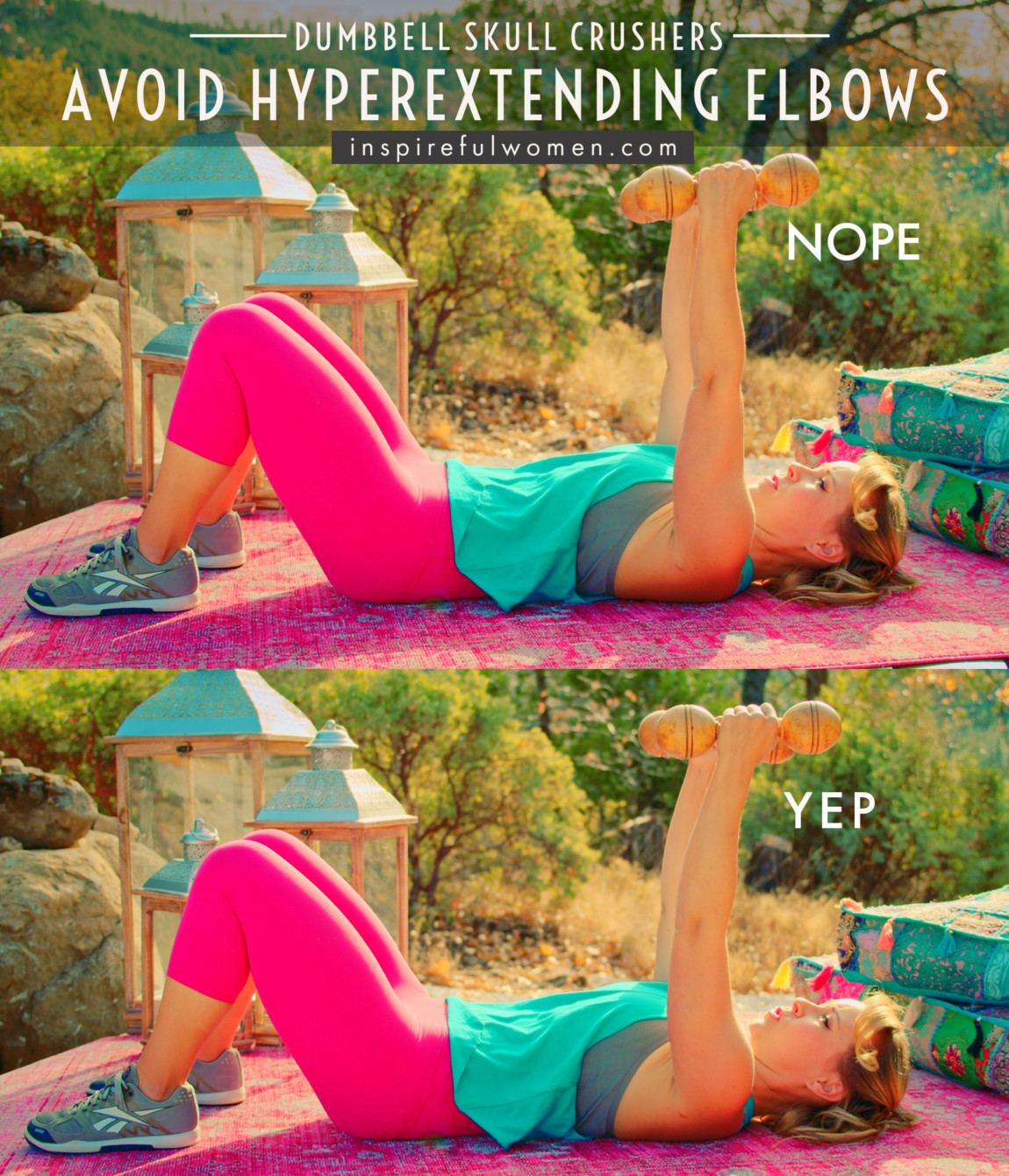
5. Avoid arching your low back
Avoid arching your low back.
- Maintain a neutral spine position to prevent low back joint injury, muscle strain or damage over time.
- Promotes poor posture
- If your ribs lower ribs flare upwards or your belly is lifted up - this indicates you are arching your low back. Your pubic bone and front hip bones should be in one plane - can check by placing finger tips on pubic bone and set base of palm on hip bones - your hand should be flat.
- Arms may be too far overhead
- The upper arm should be perpendicular to the floor
- Core muscles are not engaged
- Make sure your feet are on the floor.
- Activate your lower abdominals to hold your low back in a neutral spine position
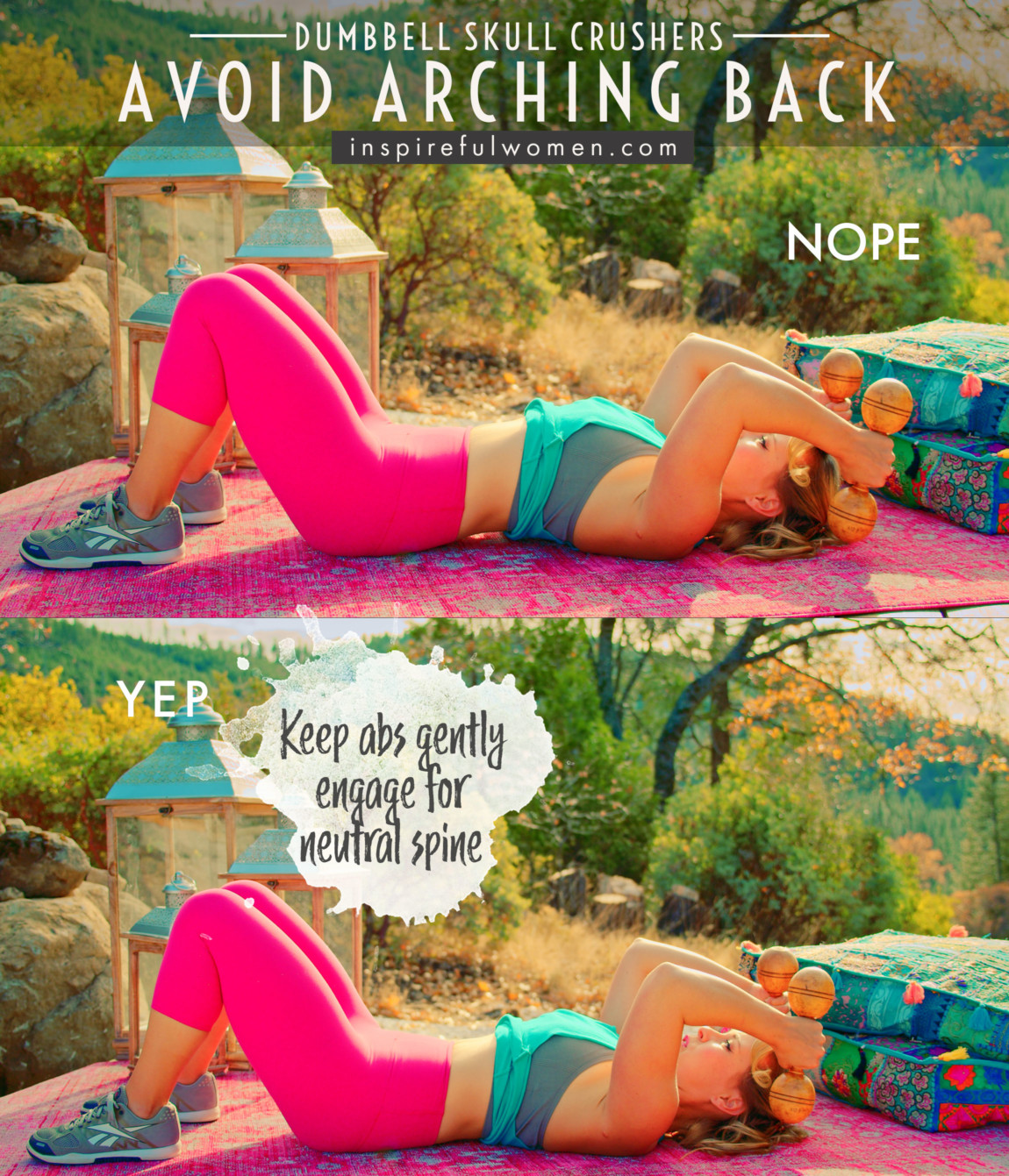
6. Avoid bending at your wrists
- Poor alignment (bent forward or backward) or repetitive movement through the wrist can lead to joint and/or soft tissue irritation or injury over time.
- You may be substituting wrist movement for arm movement.
- Keep wrists in line with the forearm and still throughout the exercise.

7. Avoid moving in pain
I personally find many triceps exercises to be rough on my elbow joints. If you struggle with this, do not just do movements in a way that puts you in pain or that you feel uncomfortable pulling or straining.
Here are some options instead:
- Use a lighter weight
- Do less range of motion - ie in this case, I don't lower my hands as far down to my head, and this feels better on my elbows.
- Choose another exercise with a different position that doesn't cause that discomfort
- Try a banded version of the same exercise - I find banded triceps moves of the same exercise hurts my elbows a lot less.
VARIATIONS
VARIATIONS
VARIATIONS OF THE DUMBBELL TRICEPS SKULL CRUSHER
palms facing you (Supinated grip)
Palms facing You - Supinated Grip
Changing your hand position can sometimes feel more comfortable for your elbows- you can try turning your palms so that they are facing you.
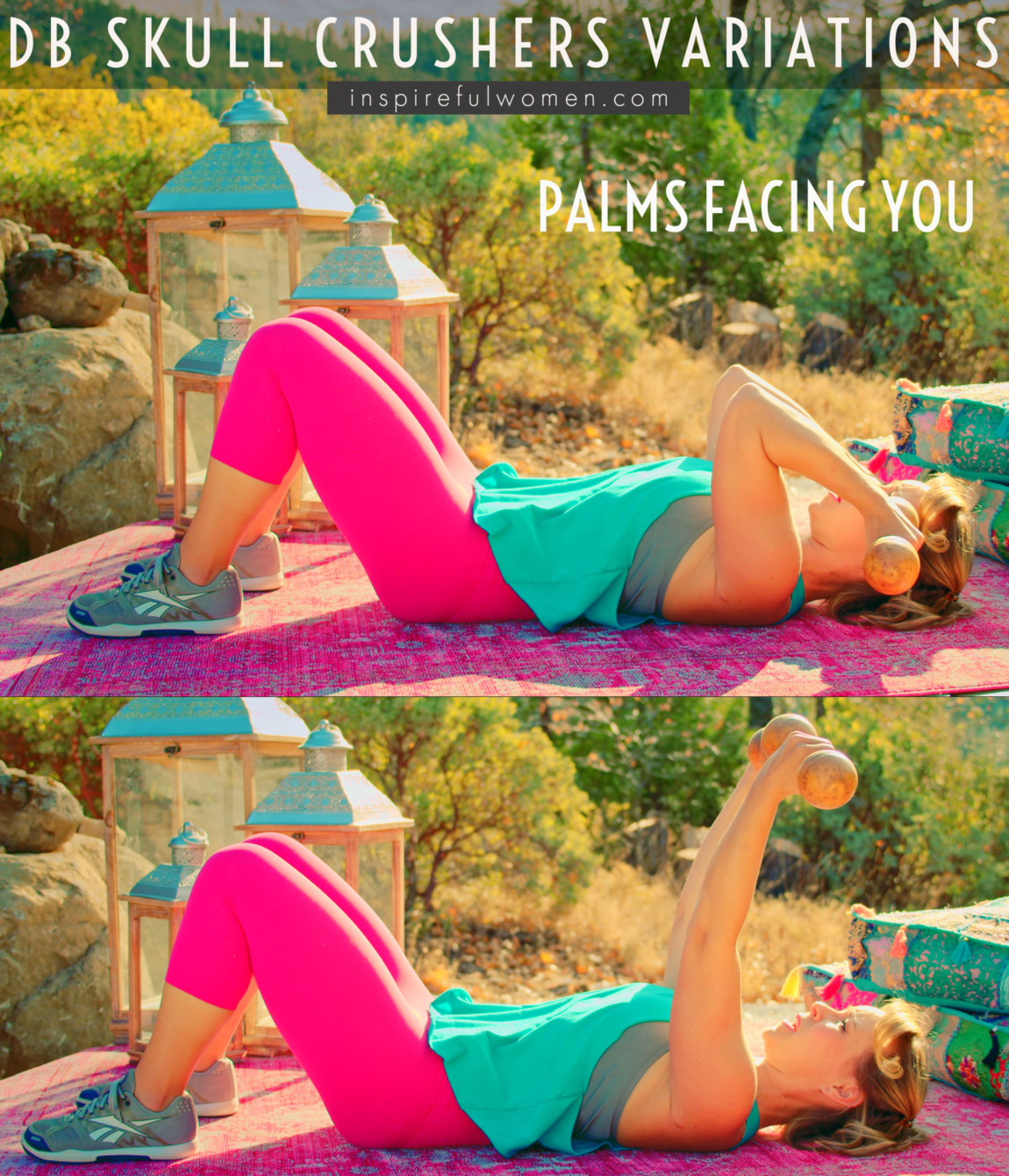
SINGLE ARM SKULL CRUSHER
Single Arm Tricep Skull Crusher
This helps you train both arms equally. Doing this exercise one arm at a time makes it harder to keep your elbow pulled in. There's 3 things you can do with the other arm:
1. Holding the nonworking arm in the starting position (elbow bent) will let the muscles relax before exercising it. Or...
2. You can lie the arm down on the torso to give it complete rest. Or.....
3. You can hold the arm at the end range of the movement - elbow straight up will work the stabilizing muscles of the shoulder, arm and core as they hold isometrically to stabilize the arm up in the air.
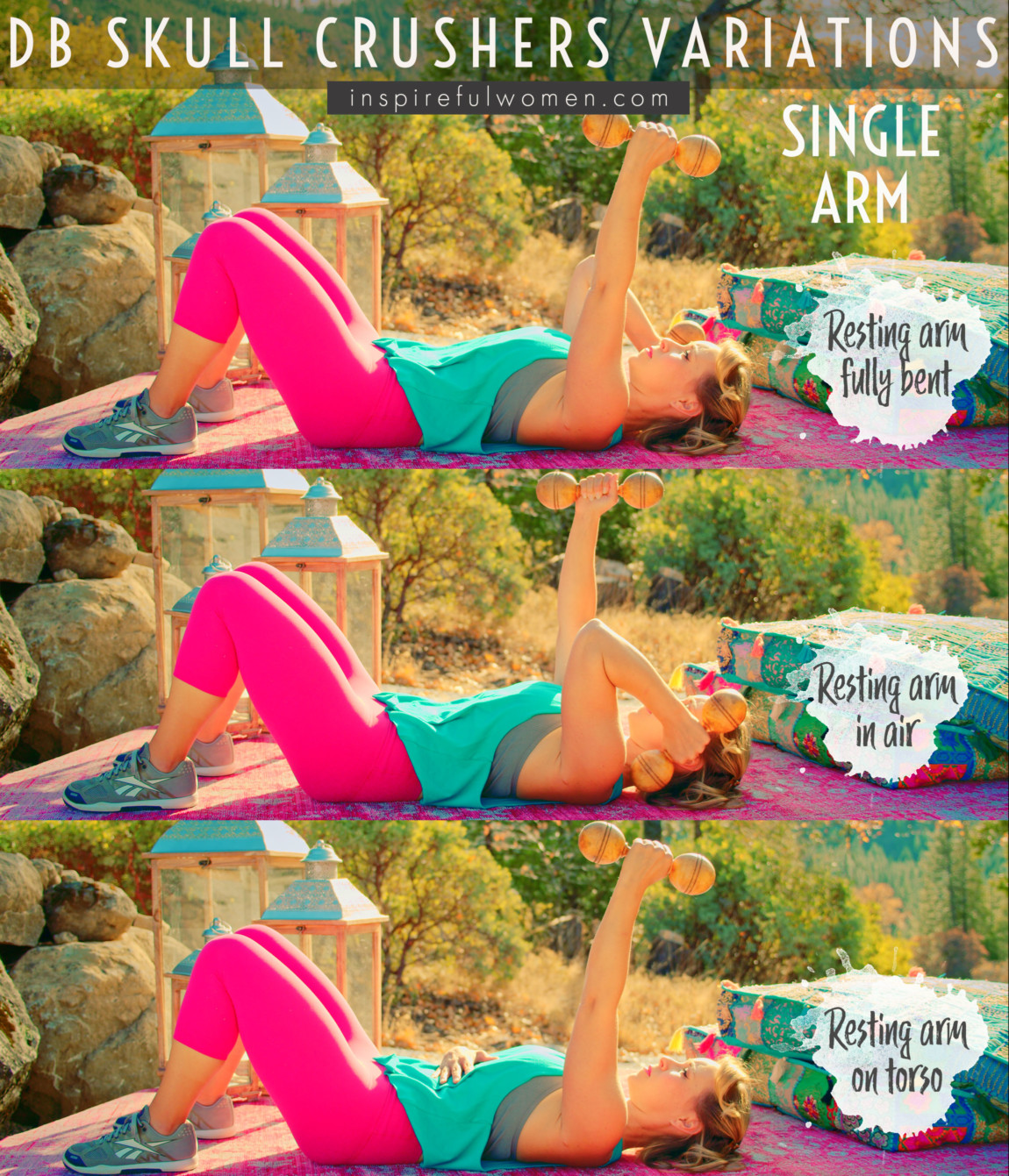
Upper arm higher
Upper Arm Higher
This involves taking your upper arm from perpendicular to a different position where you bring your upper arm further overhead a bit - so your upper arm will be angled where your elbow is closer to your head than it was. You keep it in this position and do the exercise as normal.
What this does is put the long head of the triceps muscle on stretch, which is a weaker position for the muscle- the theory is that this can help build muscle by training in a weaker position. But also be careful, as when a muscle is working in a weaker position, it can get hurt more easily - so just be aware and don't use too heavy a weight or work into discomfort or pain.
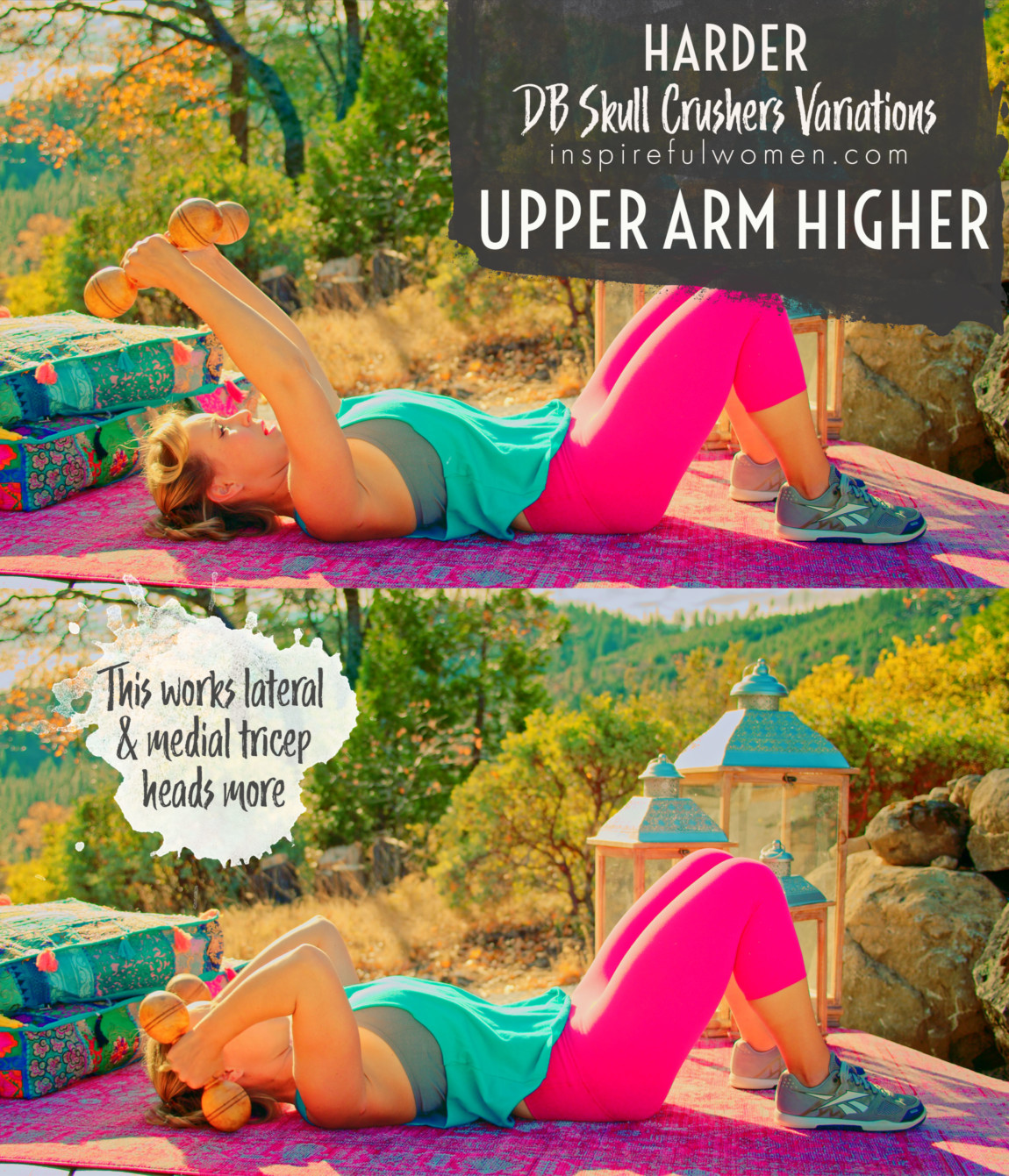
MAKE IT HARDER
HARDER
MAKING THE DUMBBELL TRICEPS SKULL CRUSHER MORE CHALLENGING
ISO Hold skull crusher
Isometric Hold
Add a 3 -5 second isometric hold when your elbows are bent 90 degrees, with the dumbbells down close to you head - this called 90 degrees of elbow flexion. Doing an isometric hold in a position where the muscle is working harder will help fatigue the muscle.

Slow Eccentric
Slow On the Down Portion - Eccentric
Eccentric is just a fancy way to say the muscle is lengthening under load or against resistance - in this exercise it's when we lower the dumbbells/bend the elbows. Lowering the dumbbells very slowly- even taking up to 10 seconds per rep, can really fatigue the muscle well.
MAKE IT EASIER
EASIER
MAKE THE DUMBBELL TRICEPS SKULL CRUSHER MORE DOABLE
PARTIAL RANGE OF MOTION
Partial ROM
You can make the skull crusher easier by only lowering the dumbbells partway. This can also feel better on the elbow joint.
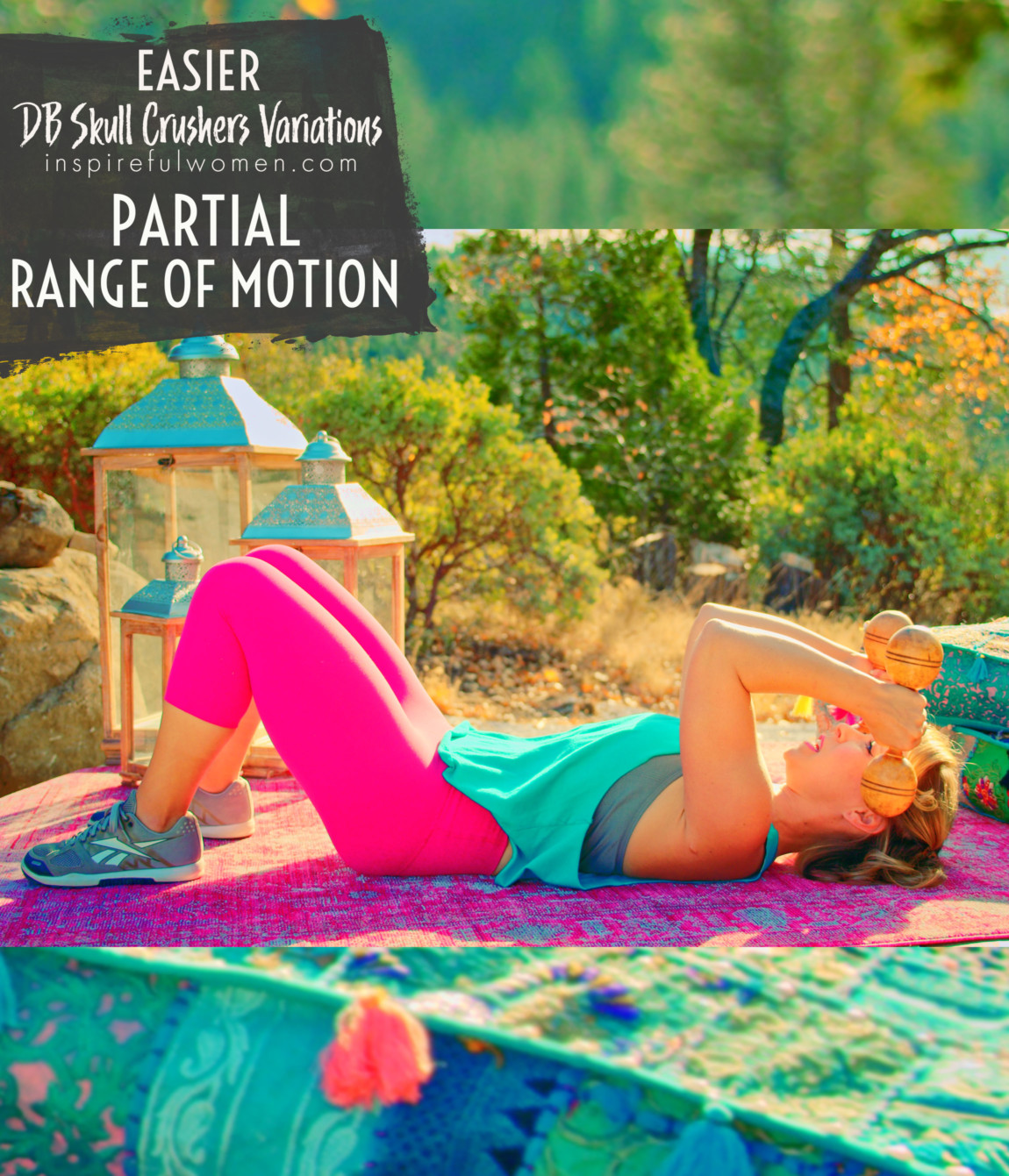
Bring upper arm down
Bring Upper Arm Down
Bring the upper arm down a bit so that you don’t have to work so hard to hold it perpendicular to the floor.
This will decrease the activity of the shoulder flexors (biceps, ant deltoid).
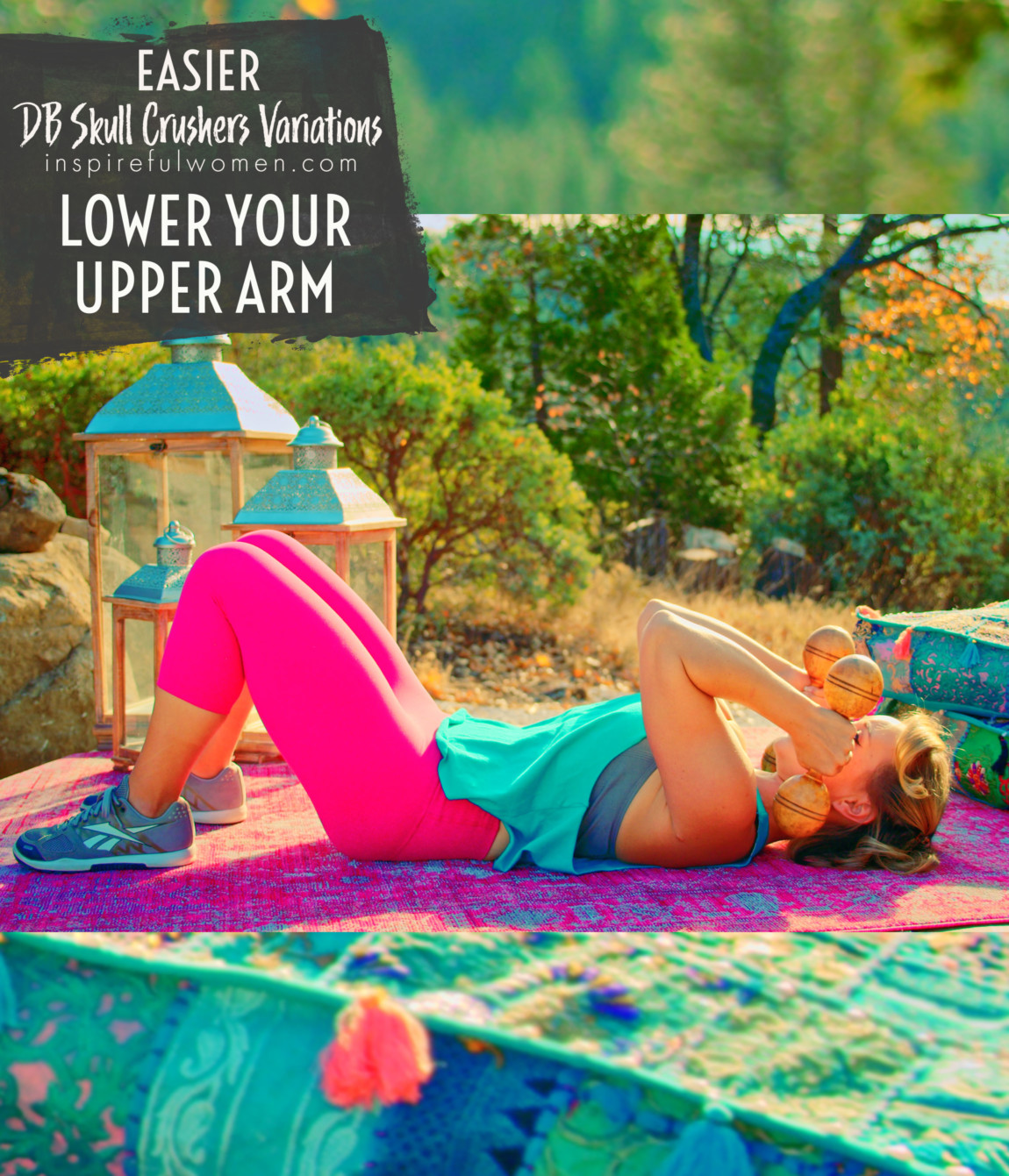
Alternating
Alternating Skull Crushers
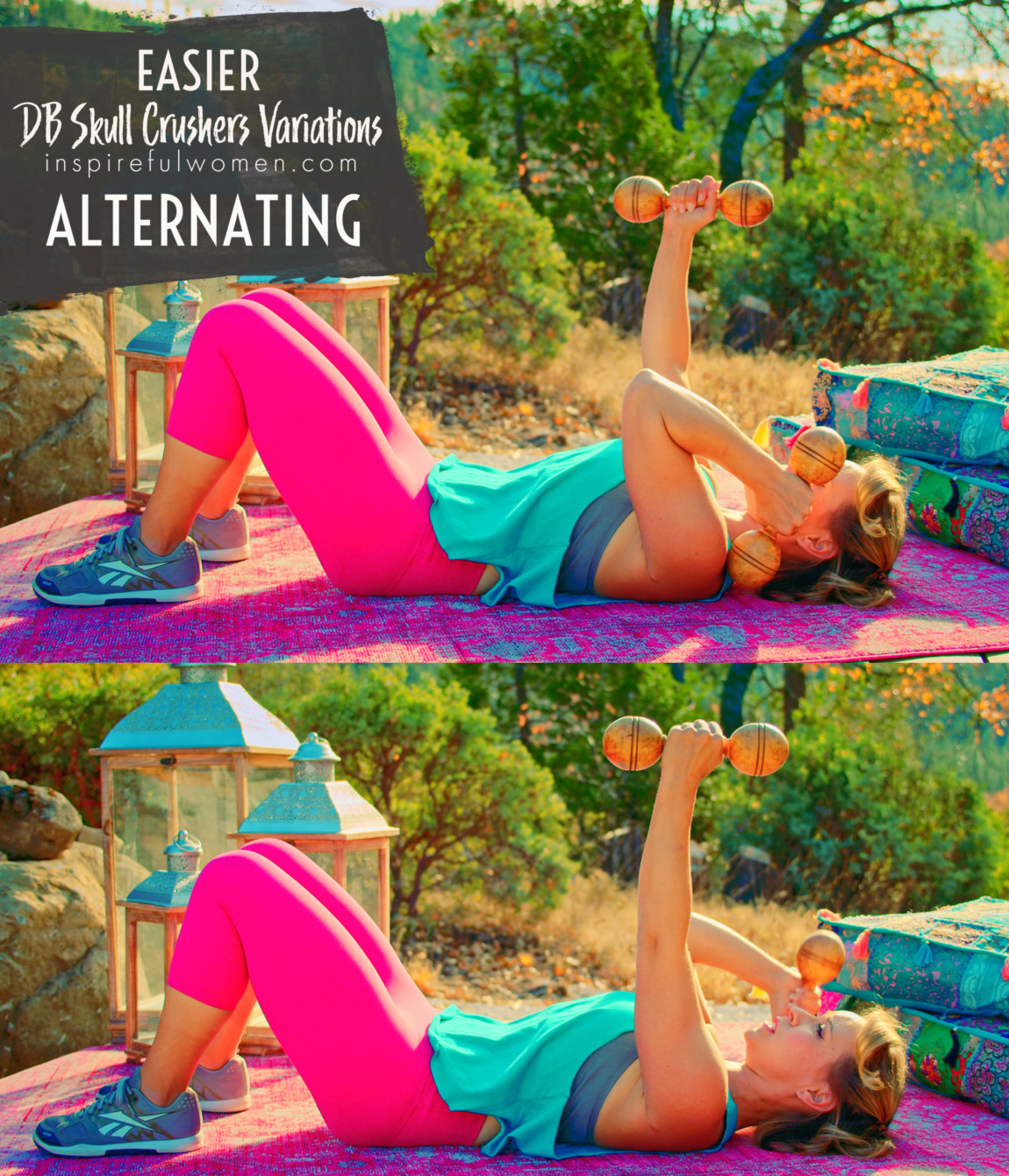
SCIENCY STUFF
SCIENCY STUFF
SPIFFILICIOUS FACTS ABOUT MUSCLES & MOVES
The triceps muscle is made up of three portions, the lateral, medial, and long heads.
All three heads of the triceps cross the elbow joint. The long head of the triceps also crosses the shoulder joint.
This muscle makes up 2/3rds of the muscle bulk of the upper arm.
The triceps lies along the backside of the upper arm and balance out the biceps brachii muscle which lies along the front of the arm.
ALLLL MUSCLES & WHEN
ALL MUSCLES WORKING & WHEN DURING THE DUMBBELL TRICEPS SKULL CRUSHER
The core muscles are active to hold the spine in a neutral position throughout the exercise.
The scapular stabilizers (mostly rhomboids, mid and lower trapezius, lats, pectoralis) are working isometrically to hold the shoulder blades in place to stabilize the upper arm.
The upper arm is positioned at 90 degrees of flexion in front of the body - the biceps, coracobrachialis, and front (anterior) deltoid hold the weighted arm in the flexed position and stabilize the shoulder joint.
The pectoralis and coracobrachialis muscles work to hold the upper arm close to the body (adduction), so the weight does not pull the arm out to the side.
All three heads of the triceps and the anconeus (relatively small contribution) muscle contract concentrically to lift the weight and straighten the elbow.
The forearm and the upper arm muscles will work together to stabilize the elbow joint as it extends.
As the weight is returned to the starting position the triceps and anconeus work eccentrically to control the load.
PIN IT FOR LATER!
